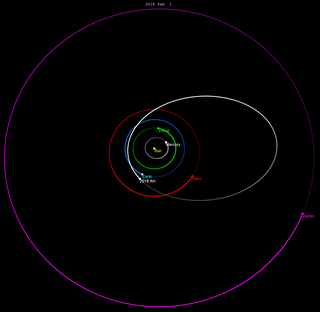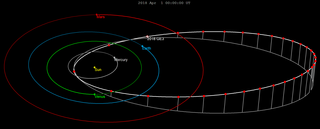| Time of discovery of asteroids which came closer to Earth than the moon in 2010 | ||
| ||
Below is the list of asteroid close approaches to Earth in 2010.
| Time of discovery of asteroids which came closer to Earth than the moon in 2010 | ||
| ||
Below is the list of asteroid close approaches to Earth in 2010.
A list of known near-Earth asteroid close approaches less than 1 lunar distance (384,400 km or 0.00256 AU) from Earth in 2010. [note 1]
Rows highlighted red indicate objects which were not discovered until after closest approach
Rows highlighted yellow indicate objects discovered less than 24 hours before closest approach
Rows highlighted green indicate objects discovered more than one week before closest approach
Rows highlighted turquoise indicate objects discovered more than 7 weeks before closest approach
Rows highlighted blue indicate objects discovered more than one year before closest approach (i.e.
objects successfully cataloged on a previous orbit, rather than being detected during final approach)
This list does not include any of the objects that collided with earth in 2010, none of which were discovered in advance, but were recorded by sensors designed to detect detonation of nuclear devices.
| Date of closest approach | Date discovered | Object | Nominal geocentric distance (AU) [note 2] | Nominal geocentric distance (LD) | Size (m) (approximate) | (H) (abs. mag) | Closer approach to Moon | Refs [1] [2] |
|---|---|---|---|---|---|---|---|---|
| 2010-01-13 | 2010-01-10 | 2010 AL30 | 0.000862 AU (129,000 km ; 80,100 mi ) | 0.34 | 9-22 | 27.2 [3] | data · 2010 AL30 | |
| 2010-02-17 | 2010-02-14 | 2010 CK19 | 0.00233 AU (349,000 km; 217,000 mi) | 0.91 | 6-16 | 27.9 [4] | data · 2010 CK19 | |
| 2010-04-18 | 2010-04-20 | 2010 HP20 | 0.00160 AU (239,000 km; 149,000 mi) | 0.62 | 8–19 | 27.5 | data · 2010 HP20 | |
| 2010-05-23 | 2010-05-20 | 2010 KO10 | 0.00116 AU (174,000 km; 108,000 mi) | 0.45 | 9-23 | 27.1 [5] | data · 2010 KO10 | |
| 2010-05-26 | 2010-05-24 | 2010 KV39 | 0.00167 AU (250,000 km; 155,000 mi) | 0.65 | 11-25 | 26.8 [6] | data · 2010 KV39 | |
| 2010-09-08 | 2010-09-05 | 2010 RX30 | 0.00166 AU (248,000 km; 154,000 mi) | 0.64 | 9-23 | 27.1 [7] | data · 2010 RX30 | |
| 2010-09-08 | 2010-09-05 | 2010 RF12 | 0.000531 AU (79,400 km; 49,400 mi) | 0.21 | 6-14 | 28.1 [8] | data · 2010 RF12 | |
| 2010-09-08 | 2010-09-10 | 2010 RK53 | 0.000482 AU (72,100 km; 44,800 mi) | 0.19 | 6-16 | 27.9 [9] | data · 2010 RK53 | |
| 2010-09-30 | 2010-09-28 | 2010 SK13 | 0.00177 AU (265,000 km; 165,000 mi) | 0.69 | 8-20 | 27.4 [10] | data · 2010 SK13 | |
| 2010-10-09 | 2010-10-11 | 2010 TW54 | 0.00108 AU (162,000 km; 100,000 mi) | 0.42 | 7-18 | 27.6 [11] | data · 2010 TW54 | |
| 2010-10-11 | 2010-10-13 | 2010 TN55 | 0.00219 AU (328,000 km; 204,000 mi) | 0.85 | 10-25 | 26.9 [12] | Yes | data · 2010 TN55 |
| 2010-10-12 | 2010-10-09 | 2010 TD54 | 0.000346 AU (51,800 km; 32,200 mi) | 0.13 | 4-10 | 28.9 [13] | data · 2010 TD54 | |
| 2010-10-16 | 2010-10-17 | 2010 UE | 0.000763 AU (114,100 km; 70,900 mi) | 0.30 | 3-7 | 29.6 [14] | data · 2010 UE | |
| 2010-10-17 | 2010-10-12 | 2010 TE55 | 0.00245 AU (367,000 km; 228,000 mi) | 0.95 | 6-15 | 28.0 [15] | Yes | data · 2010 TE55 |
| 2010-10-26 | 2010-10-30 | 2010 UY7 | 0.00163 AU (244,000 km; 152,000 mi) | 0.63 | 5-12 | 28.5 [16] | Yes | data · 2010 UY7 |
| 2010-11-02 | 2010-10-29 | 2010 UJ7 | 0.00191 AU (286,000 km; 178,000 mi) | 0.74 | 20-49 | 25.4 [17] | data · 2010 UJ7 | |
| 2010-11-02 | 2010-11-03 | 2010 VN1 | 0.000866 AU (129,600 km; 80,500 mi) | 0.34 | 5-13 | 28.3 [18] | data · 2010 VN1 | |
| 2010-11-07 | 2010-11-06 | 2010 VR21 | 0.00237 AU (355,000 km; 220,000 mi) | 0.92 | 3-10 | 29.3 [19] | data · 2010 VR21 | |
| 2010-11-12 | 2010-11-14 | 2010 VP139 | 0.000534 AU (79,900 km; 49,600 mi) | 0.21 | 3-10 | 29.2 [20] | data · 2010 VP139 | |
| 2010-11-13 | 2010-11-15 | 2010 VC140 | 0.00193 AU (289,000 km; 179,000 mi) | 0.75 | 6-16 | 27.9 [21] | data · 2010 VC140 | |
| 2010-11-17 | 2010-11-16 | 2010 WA | 0.000260 AU (38,900 km; 24,200 mi) | 0.10 | 2-6 | 30.0 [22] | data · 2010 WA | |
| 2010-11-29 | 2010-12-02 | 2010 XR | 0.00129 AU (193,000 km; 120,000 mi) | 0.50 | 10-25 | 26.9 [23] | data · 2010 XR | |
| 2010-11-30 | 2010-12-01 | 2010 XB | 0.000354 AU (53,000 km; 32,900 mi) | 0.14 | 3-7 | 29.6 [24] | data · 2010 XB |
This sub-section visualises the warning times of the close approaches listed in the above table, depending on the size of the asteroid. The sizes of the charts show the relative sizes of the asteroids to scale. For comparison, the approximate size of a person is also shown. This is based the absolute magnitude of each asteroid, an approximate measure of size based on brightness.
Abs Magnitude 30 and greater

(size of a person for comparison)
Abs Magnitude 29-30
Absolute Magnitude 28-29
Absolute Magnitude 27-28
Absolute Magnitude 26-27
Absolute Magnitude 25-26
2015 AQ43 may have passed as close as 0.00012 AU (18,000 km; 11,000 mi) (0.05 Lunar Distances) from the Earth on January 15, 2010, but the nominal distance suggests it only passed 5 LD away.

(671294) 2014 JO25 is a near-Earth asteroid. It was discovered in May 2014 by astronomers at the Catalina Sky Survey near Tucson, Arizona - a project of NASA's NEO (Near Earth Object) Observations Program in collaboration with the University of Arizona.

2018 AH is a sub-kilometer asteroid, classified as near-Earth object of the Apollo group, approximately 100 m (300 ft) in diameter. It was first observed on 4 January 2018, by the Asteroid Terrestrial-impact Last Alert System (ATLAS) on Mauna Loa and quickly followed-up by many other surveys, with precovery observations found from Pan-STARRS and PTF from the day previous.

2018 CN2 is a very small asteroid, classified as a near-Earth object of the Apollo group, approximately 5 to 16 meters in diameter. It was first observed by astronomers of the Mount Lemmon Survey at Mount Lemmon Observatory, Arizona, on 8 February 2018, one day prior its close encounter with Earth at 0.18 lunar distances.

2018 GE3 is a sub-kilometer asteroid on a highly eccentric orbit, classified as a near-Earth object of the Apollo group, approximately 48–110 meters (160–360 feet) in diameter. It was first observed on 14 April 2018, by astronomers with the Catalina Sky Survey one day prior to its sub-lunar close encounter with Earth at 0.5 lunar distance. It is one of the largest known asteroids (possibly the largest) in observational history to ever pass that close to Earth (also see list).